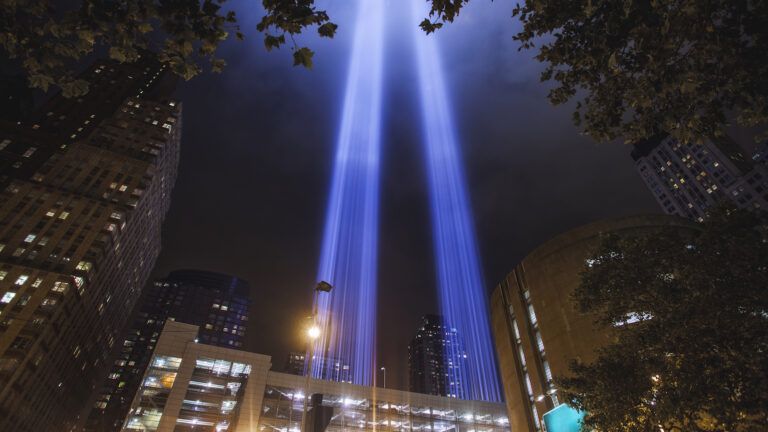I looked at the basket of yarn on the floor by my chair in the living room.
It was 7:00 p.m., the end of a long day. Can I really do this? I wondered.
Once, I’d loved knitting. I carried yarn and needles everywhere. I knit while watching TV, standing in line at the store, even on lunch breaks from my job with the customs service in the Alfred P. Murrah Federal Building in Oklahoma City.
Then on April 19, 1995, a massive bomb blast destroyed the Murrah building. A coworker found the basket in the shell of our office, two weeks after the explosion. He brought it to my house, remembering how I was never without my knitting. It had been a tearful reunion.
But later, when I took up my needles, I felt nothing. No joy. No comfort. After a few minutes I dropped the yarn into the basket. What was the point of trying to pick up where I’d left off? Nothing would ever be the same.
The basket had been sitting by my chair ever since, the skeins still covered with bits of drywall, insulation, ash. I picked up the yarn every few months, but I could never manage more than a few stitches before my mind replayed that April day.
I remembered looking out my office window at the tall elm tree in the plaza, admiring its green canopy. Chatting with two of the customs agents I worked with. Then, a deafening boom, a rain of debris, followed by an even more terrifying silence. Slowly becoming aware I was alive. Being trapped in rubble for hours. Discovering afterward that 168 people had died, including the two coworkers I’d been talking to.
I’d prayed that God would help me find comfort, some sense of meaning in my survival. But was that even possible?
Two years after the bombing, I still felt a bleakness I couldn’t escape. I was numb, shut off from everyone, everything, as if I were still trapped in the rubble, back on that terrible morning.
Until yesterday, when I watched a broadcast of other Murrah victims testifying at bomber Timothy McVeigh’s trial. They talked about their struggles to go on. A woman who’d lost her son told of not being able to sew anymore. A man said he no longer enjoyed woodworking. Anger surged through me. McVeigh is stealing our joy. I can’t let him do this.
I jumped in my car and drove to the site of the Murrah building. Through the chain-link fence that still encircled the burned-out ruins, I stared angrily at the scar in the earth, the scar that was a part of me.
Then I saw it. My tree. Half its branches were gone, but the elm was standing tall, almost defiantly. “If you can do it, I can do it,” I whispered. I went straight to the yarn store. I knew what I wanted—no, needed—to do. For the first time in months, I felt alive again.
Now I picked up the new skein of royal blue yarn I’d bought and snatched my needles from the basket. I pulled out a strand, hesitantly threading it between my finger and thumb. Once, just feeling the softness of the yarn would’ve been enough to set my hands in motion.
I’d done some beautiful work. I’d made sweaters that sold for hundreds of dollars. But the real payoff was the joy I felt inside, the kind of deep, satisfying joy that makes you feel connected to God. Could I rekindle that passion?
I made a loop from the blue yarn and slipped it over a needle, pulling the yarn tight. I made another loop, casting on again. Over and over I cast on, sliding the knots down my needle, counting as I went. Ten knots. Twenty. Thirty. It dawned on me I’d long passed the point where I usually had to stop. My fingers were nimbly working, as if someone were directing them.
Knots ran the length of a needle, nearly 80; I began stitching the ribbing for a border across the bottom of a sweater. I thought about all the people who’d died. So many lives cut short. I looked at my basket and saw a skein of red yarn, blackened in parts, covered with ash. Red…red hearts. What if I knitted 168 hearts into the border of the sweater? It would be a memorial only I could create.
The debris-littered skeins were tangible reminders of the darkest day of my life. And yet I could see purpose in intertwining new yarn with the old, a bridge between my grief and a future only God could see.
I picked up the red yarn and looped a strand around a needle. A row of hearts spread across the bottom of the sweater, then another above that. With each stitch it felt as if I were reclaiming part of my life. I was doing something that mattered. I was knitting a victory sweater.
I looked over at the clock. I’d knit for more than three hours! The back of a sweater, six inches deep, lay on my lap. I counted the hearts: 44. It was a start. There’d be more knitting, and more healing, ahead.
I pictured what I’d add to the sweater to honor my coworkers and the others lost that day: the chain-link fence, mementoes left by mourners. And, of course, my tree, with its new leaves of spring. A symbol of survival and, like my sweater, of hope.





